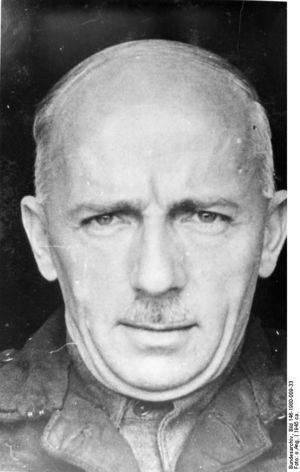Walter Dornberger
(officer, rocket scientist) | |
|---|---|
 | |
| Born | 6 September 1895 Gießen, Germany |
| Died | 27 June 1980 (Age 84) Obersasbach, Germany |
| Nationality | Germany |
| Interests | Operation Paperclip |
German rocket scientist recruited in Operation Paperclip despite use of slave labor. | |
Major-General Dr. Walter Robert Dornberger was a German Army artillery officer whose career spanned World War I and World War II. He was a leader of Nazi Germany's V-2 rocket program and other projects at the Peenemünde Army Research Center.
Postwar
In mid-August 1945, after taking part in Operation Backfire, Dornberger was escorted from Cuxhaven to London for interrogation by the British War Crimes Investigation Unit in connection with the use of slave labor in the production of V-2 rockets; he was subsequently transferred and detained for two years at Bridgend in South Wales.[1]
Along with some other German rocket scientists, Dornberger was released and brought to the United States under the auspices of Operation Paperclip and worked for the United States Air Force for three years, developing guided missiles. From 1950 to 1965, he worked for the Bell Aircraft Corporation, where he worked on several projects, rising to the post of Vice-President. He played a major role in the creation of the North American X-15 aircraft and was a key consultant for the Boeing X-20 Dyna-Soar project. He also had a role on the creation of ideas and projects, which, in the end, led to the creation of the Space Shuttle.[2][3][4]
Dornberger also developed Bell's ASM-A-2, the world's first guided nuclear air-to-surface missile developed for the Strategic Air Command.[5] Dornberger advised Germany on a European space program.[6] During the 1950s he had some differences with von Braun and was instrumental in recruiting several engineers out of the Huntsville's team for Air Force projects. The most remarkable of them was Krafft Ehricke, who later created the Centaur rocket stage and actively participated in several more Defense projects.
Following retirement, Dornberger went to Mexico and later returned to Germany, where he died in 1980 in Baden-Württemberg.
References
- ↑ Ordway, Frederick I., III; Sharpe, Mitchell R. (1979). The Rocket Team. Apogee Books Space Series. 36. New York: Thomas Y. Crowell. ISBN 0-69001656-5. page 343
- ↑ Paul Dickson (2009). A Dictionary of the Space Age. Johns Hopkins University Press. p. 199.
- ↑ https://history.nasa.gov/SP-4402/ch4.htm
- ↑ https://history.nasa.gov/SP-4221/ch2.htm
- ↑ http://content.time.com/time/magazine/article/0,9171,891876,00.html
- ↑ https://archive.org/stream/Galaxy_v22n05_1964-06_modified#page/n69/mode/2up